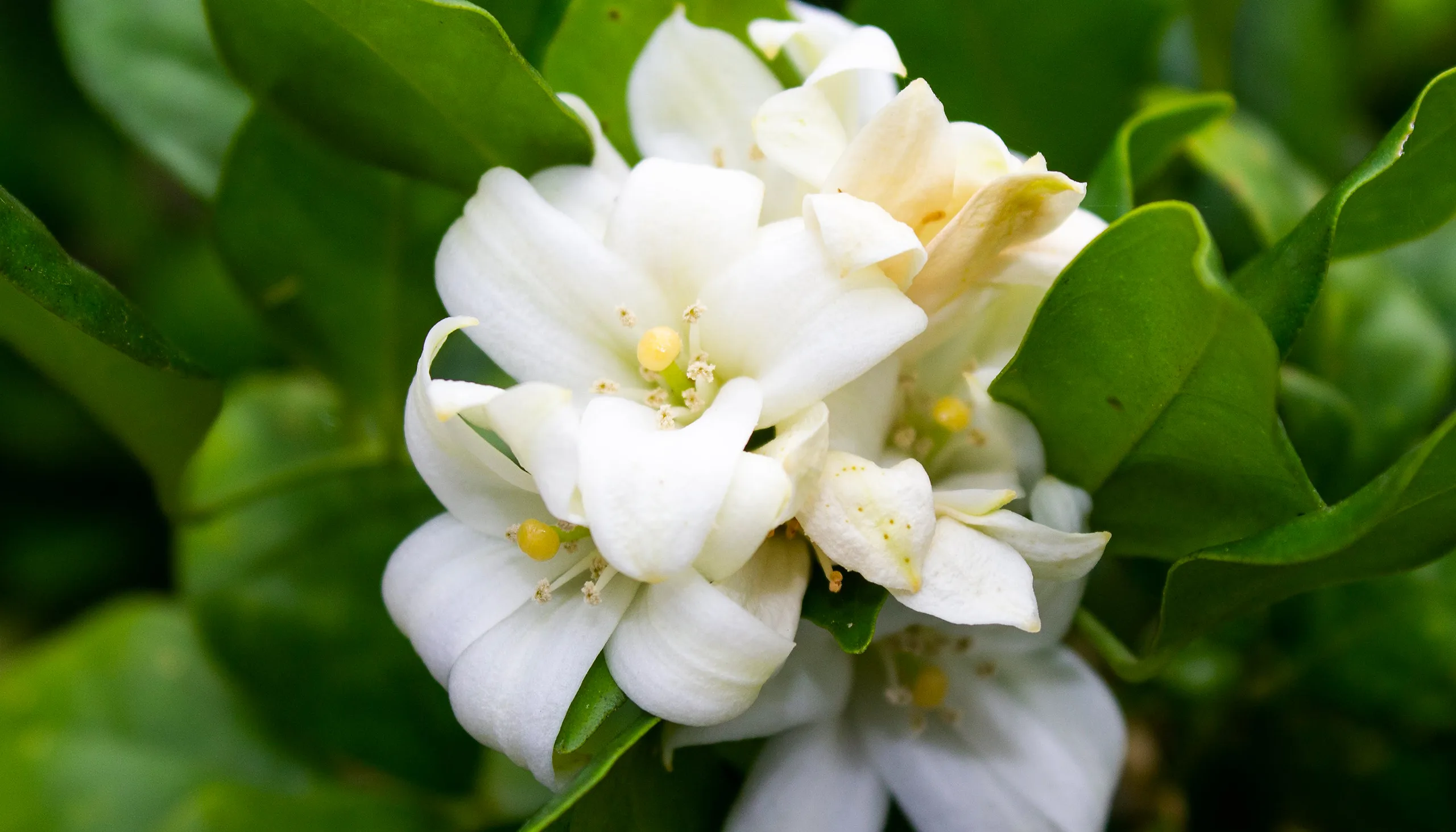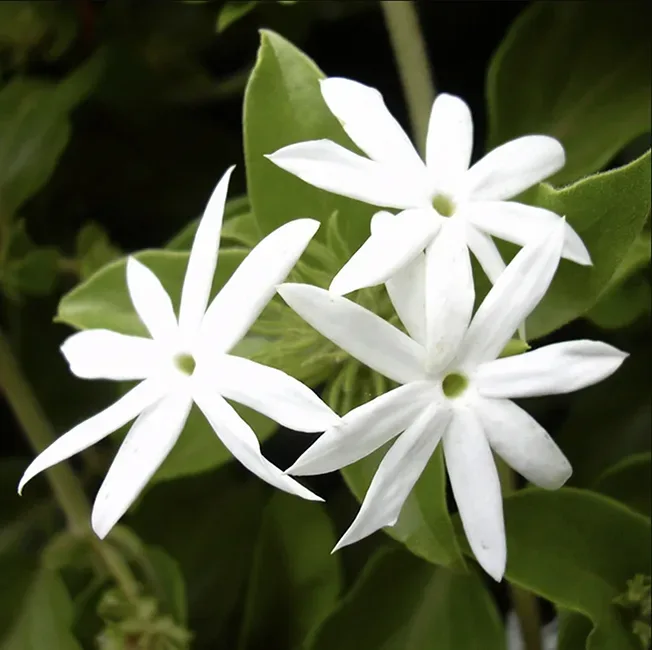
Written by s • Let’s Sort Out Jasmines and their Friends
There is nothing new or unique about botanists and ordinary folk having different names for plants. If you look at the plants gardeners call ‘cypress’ you find a whole host of very different plants under that umbrella. But with the word ‘jasmine’ you might expect life to be simple, but not so. Perhaps it’s because the flowers look very similar on many of them, and perhaps it’s because they often smell similar to each other. Regional differences play a part too, depending on what grows well in a particular part of the country. Whatever the reason, this is one group of plants that is very confused and confusing, so let’s try to sort them out a bit.
The Scent of Jasmine
To be honest, while jasmine flowers – which are usually white – are pretty enough, it’s obvious that it is the scent that draws us to them. More than 8 out of 10 commercial perfumes for women contain at least some jasmine, with it’s characteristic ‘flowers and wood’ scent. It is even found in 1 out of 3 men’s scents, so why is this aroma so popular. Maybe it’s because it has a remarkable affect on the body, reducing tiredness, stress and anxiety, and even lifting depression – no wonder we find it’s intoxicating smell addictive!
Arabian Jasmine
The first jasmine to catch human attention was Jasminum sambac, usually called Arabian jasmine, and one with a very powerful perfume that is even stronger in the bud than in the open flower. It blooms from mid-summer into early winter. This is the jasmine whose dried flowers are found in jasmine tea. It is not widely grown in gardens, perhaps because it’s an awkward, angular plant somewhere between a shrub and a climber, and it takes some experience to keep it manageable. Even more significant, it can’t take any frost, so outside of zone 10 it needs to be indoors, and the plant’s a bit big for that. Arabian jasmine has been carried around the world so much it’s hard to be sure where it came from, but it was very popular in Persia (today’s Iran) and China, so perhaps it was linked by the Silk Route. It may have been carried to Indonesia and the Philippines by Arab traders, because in those countries it is wildly popular today. The picture at the top of this blog shows a rare old variety with double blooms, called ‘Gran Duke of Tuscany’, named after the Italian Medici family of the Renaissance.
Common Jasmine
This plant, Jasminum officinale, is relatively hardy, growing in zone 7, even if some leaves drop during winter. It blooms in summer, with trusses of it’s white flowers smothering a wall or trellis.
White Jasmine
This seems like an odd name to distinguish one plant in a group that almost all have white flowers – winter jasmine is another possible name. It looks very much like common jasmine, with similar foliage and flowers, but it blooms (in warmer zones) in late winter rather than in summer. Called Jasminum polyanthum, it is another evergreen climber that can cover a large area.
Downy Jasmine

This plant is easy to recognize, because the leaves aren’t glossy, but have a soft, slightly furry feal. Called Jasminum multiflorum it a useful and tough scrambling shrub that is ideal for covering banks or spilling over walls. It won’t take frost, but it does bloom almost year-round, with a gentle, musky fragrance.
Star Jasmine
Here we get into deep waters, because this name if frequently ‘hijacked’ for the confederate jasmine described further down. It’s too bad, because that leaves us with no reliable common name for this true jasmine, called Jasminum laurifolium. Further confusing is it also being known as Jasminum nitidum! This one really isn’t frost resistant at all, but outside zone 10 it makes a handsome trailing houseplant. (Outdoors it will reach 15 feet.) It might be hard to find a reliable name for it, but it’s easy to recognize because it has 10 or 11 petals in a star, not the usual 5 we find in these plants, and the flowers are large – up to 3 inches across. It has a very attractive scent.
Other Plants Called ‘Jasmine’
“If it smells like jasmine it must be jasmine” seems to be the reason so many other plants have picked up this name. This range from shrubs like Gardenia (Cape Jasmine) to climbing plants with similar-looking white flowers, but totally unrelated. Here are a few of them:
Night-blooming jasmine – Cestrum nocturnum. This plant, somewhere between a sprawling shrub and a vine, is not really frost-proof, but it will usually re-sprout and bloom in zone 8. The powerful, penetrating perfume is loved by many and hated by some (it can be hard for perfume lovers to understand perfume haters!). The flowers stay closed during the day, and then open at dusk, releasing their powerful scent. It is a remote relative of the potato, and certainly no relative of true jasmines, but the white flowers do look similar.
Carolina Jasmine – Gelsemium sempervirens. This might be the State Flower of Carolina, but it still isn’t a real jasmine, although it’s yellow flowers don’t exclude it – (there are lots of yellow-flowered jasmines, which hardly ever have any scent, interestingly). This tough and vigorous twining plant will transform an ugly fence into a thing of beauty and the perfume is lovely.
Confederate Jasmine – Trachelospermum jasminoides. This rugged twining or groundcover vine is a staple for tough places in warmer zones, with windmill-like white blooms in spring that fill the evening with fragrance. If you live in zone 7, seek out the variety ‘Madison’, which is hardy there, will others only take zone 8. For a splash of color when not in bloom the variegated variety is a winner, with its green leaves splashed with golden yellow. It makes a great houseplant too. Unfortunately, the name ‘star jasmine’ is widely used for this plant, but if you are trying to be ‘politically correct’ and avoid ‘confederate’, there are those who thing it refers to a confederation of states in the Malaya peninsula, not to the breakaway states at all.
What About ‘Jessamine’?
One solution to the confusion that has been suggested several times, is to adopt the older name ‘Jessamine’ for all the ‘fake’ jasmine plants, keeping ‘jasmine’ for the real ones. It means the same thing, and our friend Google treats them as interchangeable. But for gardeners it would give us an easy way to acknowledge the difference, but keep them sounding much the same. This name is perhaps closer to the original Yasmin of Persian, and it was once popular as a girl’s name.





